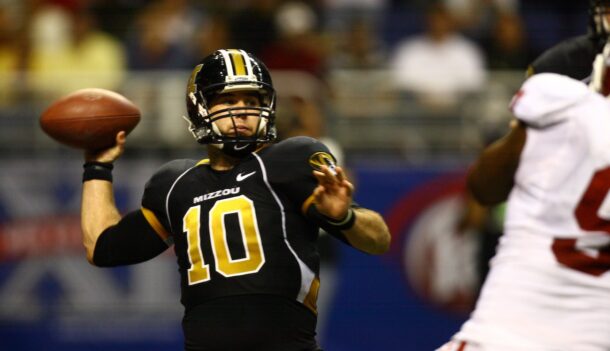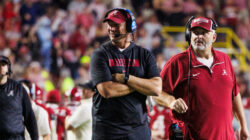
Now that college athletes can profit off NIL, let’s raise a glass (or shed a tear) for 2014 Todd Gurley
Seven years ago, ESPN’s Chris Low looked into the crystal ball and saw the future of Name, Image and Likeness. When the NCAA upheld Todd Gurley’s 4-game suspension for accepting $3,000 over the course of 2 years for selling autographed memorabilia, Low accurately predicted the beginning of the end of the NCAA’s view of amateurism.
Back in 2014, here’s what Low wrote:
The NCAA is an easy target right now, no question. But just maybe the fact the best player in college football has been sidelined will finally bring everything to a head.
It’s time for some real reform that makes sense, and not just dollars and cents for everybody but the players whom the fans come to see every Saturday.
Bingo.
No longer is the NCAA’s approach archaic as it relates to Name, Image and Likeness. Even college athletes who aren’t in states with NIL legislation in place can profit off their own names. We’re in a new era of college athletics.
If there’s anyone who deserved a bit of ex post facto, it’s Gurley.
If Gurley were to just sign autographs now with the current rules, as arguably the best player in the sport, you could’ve certainly added a zero or 2 to that measly $3,000 — star players now will make more than $3,000 for a single Instagram post — that cost him what should’ve been his best year at Georgia. No “Free Gurley” campaign would’ve been necessary.
(I realize a lot of people might be saying the same thing about Reggie Bush. The reason the former USC star is in a different camp than Gurley is because he was never suspended. We got the full Reggie Bush experience, which was incredible. Also, in terms of benefits, a house is slightly different than $3,000. But yes, he deserves his Heisman back.)
Yes, the rules were in place then, and he didn’t follow them. But not getting the full Gurley experience in college is now all the more frustrating to look back on.
It’s not frustrating from a financial standpoint, though the fact that the NCAA dropped the hammer on a kid who grew up in a trailer park for taking $3,000 while his No. 3 jerseys (without a name but who really cares) were being sold on Georgia’s team website for $134, well, I’d say that’s peak-NCAA. Fortunately, Gurley still earned just south of $50 million so far as an NFL player, which doesn’t include the money he made off ad deals.
But what about 20th-century stars like Danny Wuerffel and Tommie Frazier? Those guys had peak earning power in college, and because of when they played, they missed out on those opportunities.
Fortunately, neither of those guys had their prime college season taken away because of a suspension that aged horribly. And sure, Gurley still averaged 168 rushing yards in his 5 games vs. Power 5 competition. Without Gurley’s now-meaningless suspension, we wouldn’t have gotten the 2014, pre-injury version of Nick Chubb.
Still, though. Gurley, had he stayed healthy after returning from suspension, could’ve delivered an all-time great season.
(I’m not saying the suspension was entirely to blame for Gurley coming back and tearing his ACL, but it’s at least noteworthy. Mark Richt’s move to give him 29 carries in his first game probably deserves some blame, as well.)
There’s no doubt that a healthy Gurley would’ve delivered a historic season in 2014. It always seems like Gurley is remembered for what he did to break out as a true freshman, though as great as he was, he never had more than 130 rushing yards in a game that year. As a junior, he never had fewer than 130 rushing yards against Power 5 competition.
Remember what he did to Clemson in the opener? Against a Brent Venables defense that finished No. 3 in the nation in scoring, Gurley ran for 198 yards on 15 carries, and he returned a kick to the house:
That’s why it’s not crazy to think that Gurley could’ve challenged for Herschel Walker’s all-time single-season SEC rushing title (it was broken by Derrick Henry in 2015). Gurley’s 13-game pace in 2014 had him at 1,974 rushing yards, which would’ve been 83 yards ahead of Walker’s record.
Here are the run defense ranks of the teams Gurley didn’t face as a result of his suspension and injury:
- Mizzou: No. 27
- Arkansas: No. 12
- Florida: No. 14
- Kentucky: No. 91
- Charleston Southern: FCS
- Georgia Tech: No. 63
- Louisville: No. 10
On the surface, one would look at that and assume that Gurley would’ve probably fallen off that pace. It’s certainly possible. But against top-30 run defenses in his career, Gurley delivered these performances:
- 2012 vs. South Carolina — 13 carries, 39 yards
- 2012 vs. Florida — 27 carries, 118 yards
- 2012 vs. Ole Miss — 18 carries, 117 yards
- 2012 vs. Alabama — 23 carries, 122 yards
- 2013 vs. Georgia Tech — 20 carries, 122 yards
- 2013 vs. North Texas — 21 carries, 91 yards
- 2014 vs. Clemson — 15 carries, 198 yards
That 2012 Alabama game was against the No. 1 run defense in America … in the SEC Championship … as a true freshman.
So even if you average out Gurley’s rushing numbers vs. top-30 run defenses in his career, it’s 115 yards per game (it goes up to 128 if you remove that outlier game as a non-feature back vs. South Carolina). Apply that to the 7 games he missed and add it to his 2014 total, and Gurley would’ve had 1,718 rushing yards. A conservative estimate would’ve put him easily with a top-10 rushing season in SEC history. But again, Herschel’s mark would’ve been in play.
And who do we have to blame for not seeing that level of greatness? The NCAA. Well, at least a decent amount of it. Gurley was getting all sorts of Heisman Trophy buzz before he was handed his suspension. At the time, he ranked No. 6 in FBS in rushing yards and No. 2 in rushing yards per carry (8.2). He looked like the guy who picked up where he left off as a true freshman, and not the injury-riddled sophomore who didn’t quite have that breakaway speed.
The modern comp would be if Derek Stingley Jr. started off 2021 on an absolute tear in the first 5 games, but instead of watching the best version of him in his pre-draft season, the NCAA ruled him ineligible for 4 games … for something that was about to be legal in a few years.
It seems silly. Frustrating. It’s now more frustrating than ever.
Gurley might not have changed Georgia’s 2014 fortunes. The lack of drop-off between him and Chubb would suggest that the Dawgs didn’t suddenly have a path to a national title (Chubb averaged 143 rushing yards in those 2 losses without Gurley). It is, however, always going to be one of those thoughts we’ll always have with the new NIL rules.
Like, what if Gurley could’ve just played his career a decade later? Or rather, what if the NCAA could’ve just modernized a decade earlier?
It’s forever a shame that for the sake of Gurley and plenty of others, the NCAA never bothered to look into the crystal ball.
Connor O'Gara is the senior national columnist for Saturday Down South. He's a member of the Football Writers Association of America. After spending his entire life living in B1G country, he moved to the South in 2015.







